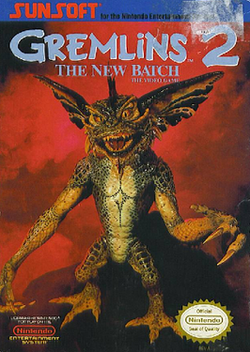| Gremlins 2: The New Batch | |
|---|---|
 North American NES box art | |
| Developer(s) | Sunsoft Riedel Software Productions Motivetime Topo Soft |
| Publisher(s) | Sunsoft Hi-Tech Expressions Elite Systems Topo Soft |
| Designer(s) | Yoshiaki Iwata |
| Programmer(s) | Keiichi Suzuki Hideyuki Udagawa |
| Composer(s) | Naoki Kodaka |
| Platform(s) | NES, Game Boy, Amiga, Atari ST, Commodore 64, DOS, MSX, Amstrad CPC, ZX Spectrum |
| Release | NES Game Boy Computer 1990 DOS
|
| Genre(s) | Platform game |
| Mode(s) | Single-player |
Gremlins 2: The New Batch is a platform video game developed and published by Sunsoft for the Nintendo Entertainment System and Game Boy video game systems in 1990. The game was released in conjunction with the film from Warner Bros. and Amblin Entertainment.